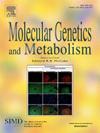代谢组学分析阐明了BOLA3在线粒体Fe-S簇中的作用
IF 3.5
2区 生物学
Q2 ENDOCRINOLOGY & METABOLISM
引用次数: 0
摘要
BOLA3是参与[4Fe-4S]簇的组装和运输的蛋白质之一,这些簇被纳入线粒体呼吸链复合物I和II、乌头酸酶和硫辛酸合成酶中。BOLA3基因的致病变异导致一种罕见的疾病,即多发性线粒体功能障碍综合征2伴高血糖症,其特征是危及生命的乳酸酸中毒、非酮症性高血糖症和肥厚性心肌病。本研究旨在阐明BOLA3变异患者的生化特征,阐明BOLA3蛋白在人体中的作用。收集8例日本BOLA3致病变异患者的特点、临床病程及生化资料。此外,使用毛细管电泳飞行时间质谱、蓝色天然聚丙烯酰胺凝胶电泳(bm - page)/线粒体呼吸链复合物的Western blot分析和成纤维细胞线粒体呼吸链复合物的凝胶内酶染色进行代谢组学分析。采用Welch’st检验比较8例BOLA3变异患者和3例对照样本的代谢组学数据。代谢组学分析显示,BOLA3组乳酸、丙酮酸、丙氨酸、三羧酸(TCA)循环中间体(如α-酮戊二酸和琥珀酸)、支链氨基酸、赖氨酸和色氨酸代谢物水平显著升高。在患者生命期间收集的数据显示乳酸和甘氨酸水平升高。在BN-PAGE/Western blot分析和凝胶酶染色中,在所有8例中几乎检测不到复合物I和II的条带。这些结果表明,BOLA3突变体降低了硫辛酸依赖蛋白(丙酮酸脱氢酶复合物、α-酮戊二酸脱氢酶、2-氧己二酸脱氢酶、支链酮酸脱氢酶和甘氨酸裂解系统)以及线粒体呼吸链复合物I和II的活性,但不影响乌头酶。因此,我们认为BOLA3参与了[4Fe-4S]簇向呼吸链复合物I和II和硫辛酸合成酶的转运,但不干扰乌头酸酶。这些发现表明,虽然硫辛酸补充或维生素鸡尾酒可能提供益处,但受损的[4Fe-4S]簇途径本身应该作为治疗的目标,以改善BOLA3缺乏引起的广泛代谢异常。本文章由计算机程序翻译,如有差异,请以英文原文为准。
Role of BOLA3 in the mitochondrial Fe-S cluster clarified by metabolomic analysis
BOLA3 is one of the proteins involved in the assembly and transport of [4Fe-4S] clusters, which are incorporated into mitochondrial respiratory chain complexes I and II, aconitase, and lipoic acid synthetase. Pathogenic variants in the BOLA3 gene cause a rare condition known as multiple mitochondrial dysfunctions syndrome 2 with hyperglycinemia, characterized by life-threatening lactic acidosis, nonketotic hyperglycinemia, and hypertrophic cardiomyopathy.
The aim of this study was to elucidate the biochemical characteristics of patients with BOLA3 variants and to clarify the role of BOLA3 protein in humans. The characteristics, clinical course, and biochemical data of eight Japanese patients with BOLA3 pathogenic variants were collected. In addition, metabolomic analyses were performed using capillary electrophoresis time-of-flight mass spectrometry, blue native polyacrylamide gel electrophoresis (BN-PAGE)/Western blot analysis of mitochondrial respiratory chain complexes, and in-gel enzyme staining of mitochondrial respiratory chain complexes of fibroblasts from all eight patients. Metabolomic data were compared between the eight patients with BOLA3 variants and three control samples using Welch's t-test. In the metabolomic analysis, levels of lactic acid, pyruvic acid, alanine, tricarboxylic acid (TCA) cycle intermediates (such as α-ketoglutaric acid and succinic acid), branched-chain amino acids, and metabolites of lysine and tryptophan were significantly elevated in the BOLA3 group. Data collected during the patients' lives showed increased lactic acid and glycine levels. In BN-PAGE/Western blot analysis and in-gel enzyme staining, bands for complexes I and II were barely detectable in all eight cases. These results indicate that BOLA3 variants decrease the activity of lipoic acid-dependent proteins (pyruvate dehydrogenase complex, α-ketoglutarate dehydrogenase, 2-oxoadipate dehydrogenase, branched-chain ketoacid dehydrogenase, and the glycine cleavage system), as well as mitochondrial respiratory chain complexes I and II, but do not affect aconitase. Thus, it is believed that BOLA3 is involved in transporting [4Fe-4S] clusters to respiratory chain complexes I and II and lipoic acid synthetase, but does not interfere with aconitase. These findings suggest that while lipoic acid supplementation or vitamin cocktails may provide benefits, the impaired [4Fe-4S] cluster pathway itself should be targeted for treatment to improve the extensive metabolic abnormalities caused by BOLA3 deficiency.
求助全文
通过发布文献求助,成功后即可免费获取论文全文。
去求助
来源期刊

Molecular genetics and metabolism
生物-生化与分子生物学
CiteScore
5.90
自引率
7.90%
发文量
621
审稿时长
34 days
期刊介绍:
Molecular Genetics and Metabolism contributes to the understanding of the metabolic and molecular basis of disease. This peer reviewed journal publishes articles describing investigations that use the tools of biochemical genetics and molecular genetics for studies of normal and disease states in humans and animal models.
 求助内容:
求助内容: 应助结果提醒方式:
应助结果提醒方式:


